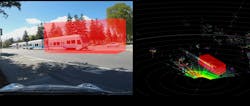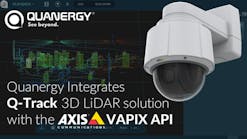Lidar comes of age in security
With all of the technological advancements taking place across the security industry these days, it’s easy for some solutions to get lost in the shuffle. From machine learning and advanced video analytics to facial recognition systems and robotics, the market seems awash in products that promise to revolutionize day-to-day security operations for organizations both big and small.
One technology that has flown under the radar among these other industry innovations is light detection and ranging, known as lidar, for short. Lidar solutions leverage lasers to measure reflected light off of objects to create a 3D image of an area. The technology, which is known primarily for the vital role it plays it in autonomous vehicle development, also holds enormous potential for security applications.
Unlike a surveillance camera that measures ambient light and captures associated images, Derek Frome, Director of Marketing for Ouster, which is showcasing its OS-1-64 Lidar and Object Tracking sensor at this year’s GSX conference in Chicago (Booth #1976), lidar is an active illumination sensor that sends out light (laser pulses) enabling users to reconstruct an environment in great detail.
“Based on the speed of light, we can tell exactly how far away something was and so you can imagine across 1.3 million data points per second, you can get a very high-resolution 3D creation of an environment. Whether it is daytime or nighttime, it doesn’t matter,” Frome says.
According to William Muller, Director of Business Development at Cepton Technologies, which is exhibiting for the first time at GSX this year (Booth #1894), lidar provides a wealth of information about a given environment – i.e. size, direction and velocity of objects – within centimeters of accuracy that just isn’t possible with other technologies.
“One differentiator for lidar compared to other technologies is that we have zero emissions. Radar and microwave (technologies) emit frequencies of some sort, while fiber optics emit only light but it is not as accurate. And, of course, we are all used to video-based images – thermal or megapixel cameras – but a lot of those devices struggle to position an object in the field of view to say that that object is 10, 15 or 20 meters away,” Muller explains. “For lidar, however, it is easy to say that an object is, for example, 55 meters away, and then take another available resource like a PTZ camera and it can give accurate information to say that target is something of interest. It’s really an old technology being modified for new world challenges. Especially in security, there hasn’t been a lot of new, innovative hardware… so this just adds that next layer of proactive threat detection.”
Differences in Lidar Offerings
What separates Ouster, which received the 2019 GSX Innovative Product Award in the “Judge’s Choice” category for the aforementioned OS-1-64 sensor, from other lidar vendors, according to Frome, is the resolution offered by their sensor which today stands at 64 channels.
“A 64-channel sensor is easily human-readable,” Frome says. “You can tell a person from quite a ways away, you can tell animals, vehicles or whatever it is. The other half of the coin is the price. We have a very aggressive price point in the market which really allows us to even be considered for applications like security. A lot of lidar companies are selling sensors for $30,000 to $100,000 each and the cost-benefit analysis gets thrown pretty out of whack for a use case like security when talking about a sensor that costs tens of thousands of dollars. Our 16-channel sensor is $3,500 and our 64-channel sensor is $12,000 in single-unit quantities and obviously we are able to offer discounts for larger purchases.”
Realizing that high-resolution lidar would need to migrate away from traditional analog components to a semi-conductor-based supply chain to be leverage in autonomous vehicles and other applications, Frome says Ousters founders set out to develop the world’s first digital lidar sensor.
“That’s really what we’ve been working on and the products we’ve launched basically take what would be a many thousands of components analog device and we condense it down into two integrated semiconductor chips,” he explains. “We have a laser array on one chip and a receiver called a SPAD (single-photon avalanche diode), which is a CMOS sensor similar to digital photography, on the other.
“It’s a very different technology, a totally different supply chain and what it allows us to do is really deliver that high performance,” Frome continues. “Similar to how Intel ships a processor every year that is about twice good and also has cost reductions, we have a similar situation where last year we brought out the OS-1-64, which has 64 lines of resolutions and this year we’re bringing out the 128-channel sensor. We see that trend continuing for many years to a point where we have lidar that you can truly call HD and that gets interesting for a lot of different industries, security included.”
Whereas lidar solutions are still in the development stages within many companies, Muller says Cepton is one of the few to bring an actual solution to the market.
“A lot of the other lidar manufacturers are just focused on making sensors but we’ve developed the whole package,” he says. “We’re taking that lidar data and we are presenting usable information with what that technology is seeing and that is the classification and detection of these objects or potential threats being human or a vehicle, etc.”
Integration with Other Security Systems
In addition to presenting its solution to the market, Cepton has also announced a new partnership with CNL at GSX. Under this new partnership, Cepton’s smart lidar network, Helius, will be integrated with CNL’s PSIM software to enable automation of threat detection, tracking, and escalation in real-time.
“The core of Cepton’s design is very open source so we are driving a partner ecosystem model. We want to allow as many partners and other systems to receive our information,” Muller adds. “I wouldn’t say we are a total solution, but we offer a layer that goes a long way in providing that full solution.”
While Ouster hasn’t integrated its lidar sensor with any other security hardware or software solutions on the market, Frome says that some installers have integrated their technology with camera systems and other products, such as proximity alarms and things along those lines. “The data that comes off of (the sensor) is just raw data so you can do all sorts of machine learning, perception algorithms on top of the sensor data as well,” he adds.
Vertical Markets Applications
Within the security industry, Frome says Ouster has received a lot of interest from end-users for various perimeter security applications, such as securing military bases, corporate campuses, and airports and seaports.
“We see a promising amount of interest. People who are sort of on the cutting-edge of the security industry are, I would say, quite well aware of the advantages that lidar can bring for them. We have a lot of early adopters that are very interested in this,” he says. “Getting to the meat of the bell curve in terms of sophistication and willingness to experiment is a challenge and that’s what we see happening within the next couple of years.”
In addition, Muller says that Cepton has garnered a lot of interest for its solution in critical infrastructure and smart city applications and adds that they’ve engineered it to provide data beyond what would be typical in a security deployment.
“There’s a couple of things we realized with lidar: one is you have to look at the return on investment for any technology – what can it do for you over and above what its sole purpose might be? There’s a lot of other metadata available in our system by default that allows integrator partners to kind of upsell the solution beyond being a security solution,” he says. “Secondly, new technology tends to be scary to adopt. If you think of the history behind analog vs. IP (surveillance), it has taken a long time and there are still a lot of systems in the process of migrating. The approach we’ve taken is to build something that is familiar to a lot of customers… so our lidar, the way it acts, the way it behaves and the way you interact with it is very much like a camera.”
About the Author:
Joel Griffin is the Editor of SecurityInfoWatch.com and a veteran security journalist. You can reach him at [email protected].



